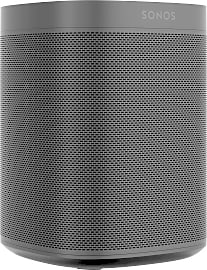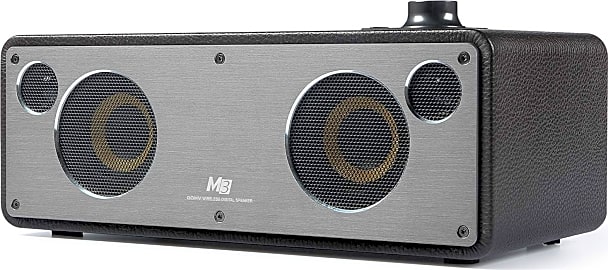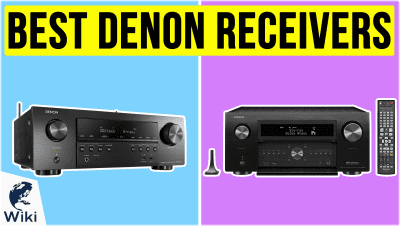The 10 Best Airplay Speakers

This wiki has been updated 38 times since it was first published in May of 2015. Nothing spoils a great sound system like poor connectivity. For many owners of Apple phones, tablets, and computers, one of the easiest ways to ensure seamless playback of high-fidelity audio over a wireless network is with one of these AirPlay speakers. The technology works everywhere within the boundaries of a Wi-Fi signal, so you never have to worry about cords that don't reach. When users buy our independently chosen editorial selections, we may earn commissions to help fund the Wiki.
Editor's Notes
April 28, 2020:
While a few of the models from our previous list saw some upgrades in recent days, like the AxiomAir Portable with its newly designed housing and built-in battery, others have either gotten too long in the tooth or offered sub-par features compared to the rest of the market to justify staying on the list. The Harman Kardon Aura Plus is a great example of this, as it put form so far ahead of function that it found itself seeming bulky and dated without even providing particularly good sound.
Among the new models to find a spot on our list is the Bang & Olufsen Beosound Stage, which completely obliterates other soundbars, and stands to compete with just about any center channel speaker in a surround sound setup on the market, especially as it can represent left and right channels in addition to its centered performance. And its aesthetic versatility and placement options make it a smart choice for anyone who can afford it. The Denon Home 250 Wireless offers many of those same qualities without the visual statement, and is a great choice for anyone with a Denon receiver, as it can perform particularly well with their wireless HEOS system.
Special Honors
Moshi Spatia If sound quality is more important to you than anything else, this might be a smart option. It offers a pair of 2.75-inch drivers for all your mids, two one-inch silk tweeters for the highs, and a down-facing four-inch subwoofer. It's easy to set up and responsive to subtle changes in EQ, but it takes up a lot of space. moshi.com
Airplay Vs. Bluetooth
That said, Airplay seems to offer more advantages over the average Bluetooth-enabled devices.
Airplay is a wireless sound technology developed by Apple and used primarily for streaming music or other audio to a variety of devices. It works through your home WiFi network to deliver high-quality sounds from your iPhone or other Apple device to your Airplay speakers. Each device used for streaming and playing the audio must be Airplay supported, and there must be an available WiFi connection in order for the service to work.
You might be wondering why you wouldn’t just invest in a set of Bluetooth speakers. After all, Bluetooth doesn’t require the use of a WiFi network and is compatible with Android devices as well, right? Fortunately for audio lovers, there are a wide range of options from which to choose in both the Airplay and Bluetooth speaker market. That said, Airplay seems to offer more advantages over the average Bluetooth-enabled devices.
While both Bluetooth and Airplay are created for wireless connection and streaming, Airplay delivers a higher quality sound. Because it operates over a WiFi network, and is specifically equipped in certain devices, it is designed for clear, crisp audio. Its most useful application is at home across multiple devices, allowing you to create either a surround sound situation or, in many cases, the ability to play different tunes in each room.
Bluetooth technology is designed for convenience and portability. If you are frequently in places with no WiFi connection, but still want to stream your music or other audio, then Bluetooth is the way to go.
However, if you're looking for both quality and convenience around your home or office, consider buying Airplay speakers. All Airplay speakers are compatible with Apple devices, and some even come equipped with Bluetooth and Android compatibility as well. While it's true that Bluetooth will likely run at a lower price, Airplay is the way to go for more quality and convenience, provided you have a readily available WiFi network.
Because Apple has made the technology available to other manufacturers, there are many wireless speakers on the market from a wide variety of companies equipped with Airplay capabilities. That means you now have the option of choosing a high-quality speaker that you can operate from your phone, tablet, or computer within a reasonable budget.
Advantages Of Airplay
There are a number of advantages to using Airplay besides sound quality alone, making it a versatile audio solution when networks come into play.
First, Airplay allows you to pick a specific speaker in your home. If you have Airplay speakers and other Airplay-enabled devices around your home, you can choose to stream your music or other audio to any one of these locations or even choose multiple locations at one time for a full, surround-sound experience.
Major brands such as Philips, Sony, and Yamaha offer such devices to be used in addition to your standalone Airplay speakers.
Second, more and more amplifiers and other receivers are being equipped with Airplay capabilities meaning that you can also stream Airplay to these devices for an enhanced audio experience. Major brands such as Philips, Sony, and Yamaha offer such devices to be used in addition to your standalone Airplay speakers.
Third, Airplay is versatile enough to stream over an Ethernet connection. Occasionally, you might run into an Airplay-enabled device that struggles to pick up the WiFi signal. It could be due to the device or the quality of the WiFi connection itself. Regardless, if your receiver has an Ethernet connection port, this issue can be easily resolved.
Next, Airplay can not only be streamed from a Mac, but the Mac can be used as an Airplay receiver as well. A simple software download allows you to stream music and other audio from your iOS device to your Mac computer or from one Mac to another.
Finally, the popularity and availability of Airplay are making it possible to use your Android phone to control Airplay. Some newer Android phones are being created to be compatible with Airplay and operate just like the iOS devices used to facilitate audio streaming.
A Brief History Of The Airplay Speaker
Although available under the name “AirTunes” for several years prior, Airplay made its official debut in the fall of 2010 . It was based on the idea that streaming music over a WiFi connection would be much more efficient and at a higher quality than that of Bluetooth.
It took several years for this technology to be converted to AirPlay so video and audio could be streamed together.
In 2004, when the technology was still known as AirTunes, a man named Jon Lech Johansen reverse-engineered the protocol so that it could be utilized on a variety of devices. It took several years for this technology to be converted to AirPlay so video and audio could be streamed together.
Apple developed a free app to use in conjunction with Airplay so the feature could be easily controlled using a mobile phone, tablet, or computer. When AirTunes was first developed, it was for audio use only. However, Airplay allows for video streaming as well. Similarly, AirTunes was specifically for Apple products only, while Airplay technology has been made available to a wide range of manufacturers so many products can be compatible.
In 2011, Steve Jobs announced the invention of Airplay Mirroring that would allow for wireless video streaming directly from an iPad to a compatible HDTV. As of right now, an AppleTV is required in order to utilize this feature, as it has not been sufficiently tested and made compatible with other receiving devices. It works best when being sent from specific types of Mac computers.















